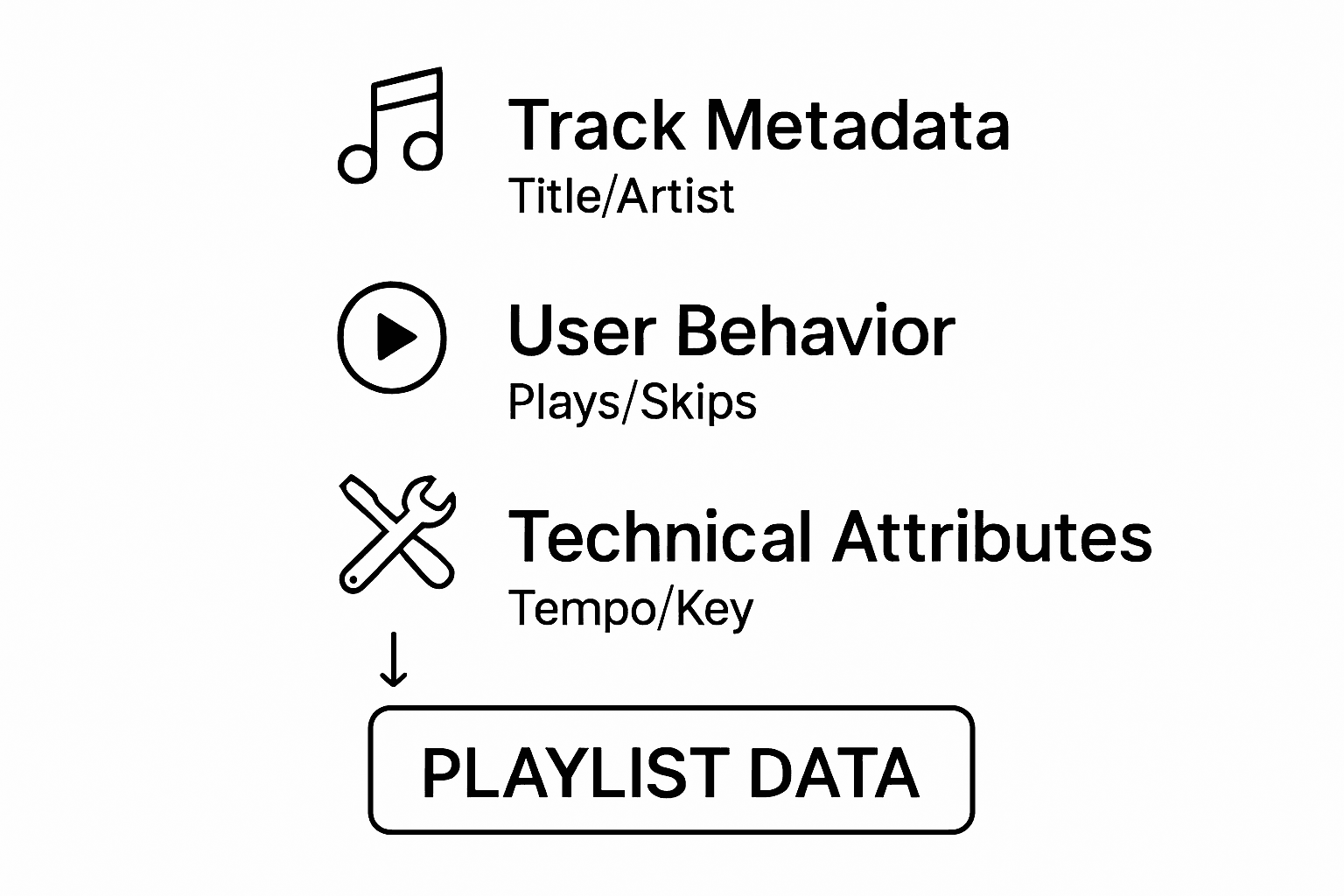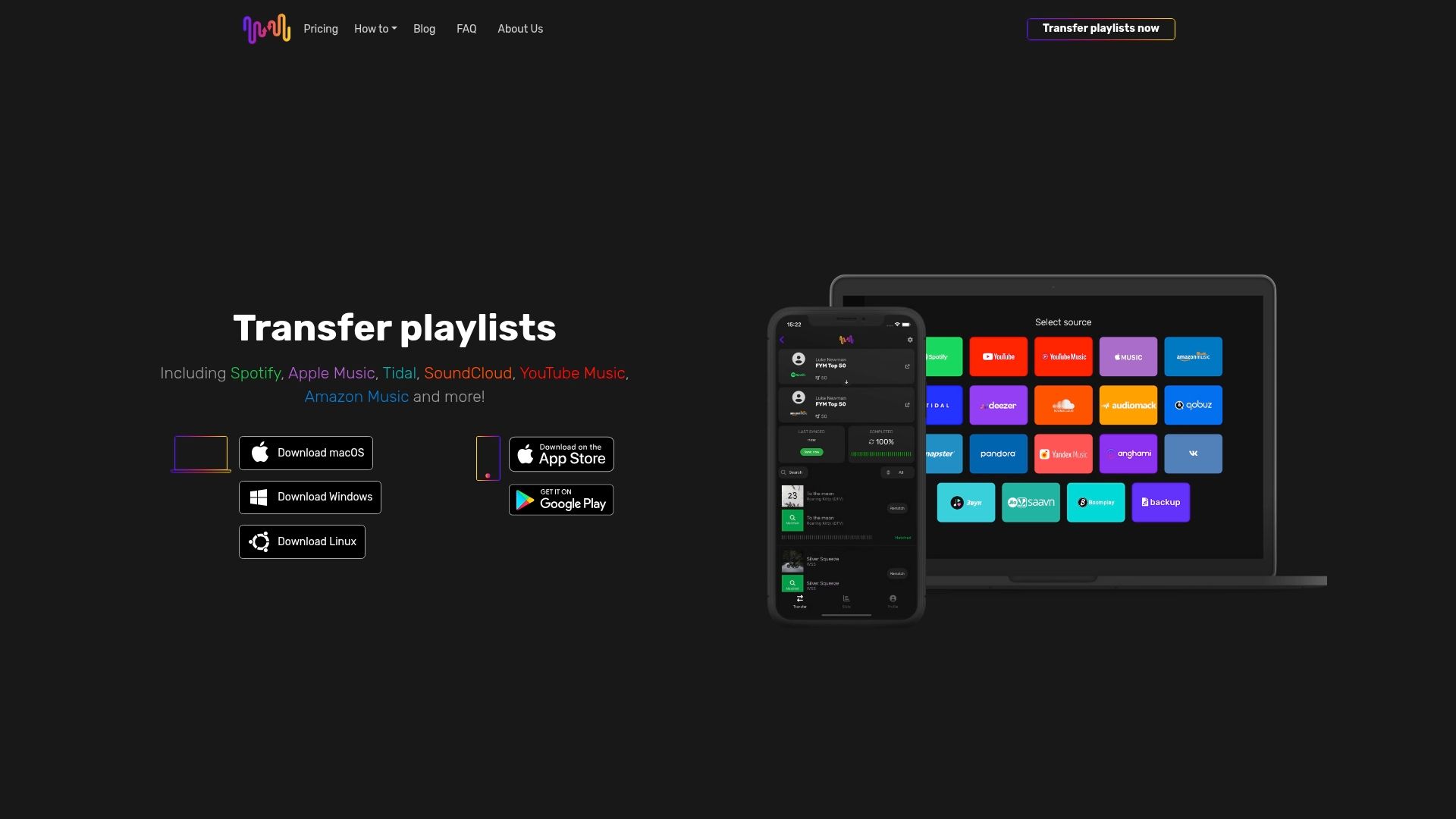Music playlist data sounds like just a list of songs lined up for your next drive or workout. But the real story is that digital music services use this data to power the smart recommendations that keep over 82% of users listening longer. Turns out, playlist data is not just about tracks and albums. It is a secret code for unlocking personal taste and turning every playlist into a living fingerprint of who you are as a listener.
Table of Contents
- Defining Music Playlist Data: Core Concepts Explained
- The Fundamental Structure of Playlist Data
- Significance in Music Streaming Ecosystems
- The Importance of Music Playlist Data in Streaming Services
- Personalization and User Experience Enhancement
- Economic and Strategic Value of Playlist Metadata
- How Music Playlist Data Influences User Experience
- Emotional Connectivity Through Data Analytics
- Personalization and Predictive Recommendations
- Key Components of Music Playlist Data: An In-Depth Look
- Track and Metadata Fundamentals
- User Interaction and Behavioral Metrics
- Real-World Applications of Music Playlist Data in the Industry
- Strategic Music Industry Innovations
- Commercial and Creative Ecosystem Transformations
Quick Summary
| Takeaway | Explanation |
|---|---|
| Playlist data enhances music recommendations | Streaming platforms use detailed playlist data to provide personalized music suggestions based on user preferences and behaviors. |
| User interactions shape listening experiences | Metrics like play counts and skip rates inform how playlists are generated and refined, enhancing the listening experience. |
| Playlist data reveals emotional connections | By analyzing user engagement, platforms can discern mood and context, creating playlists that resonate with listeners emotionally. |
| Music playlist data drives economic value | This data assists streaming services in retaining users and finding new revenue sources through targeted marketing strategies. |
| Innovative applications of playlist data exist | Organizations utilize playlist data for artist discovery and effective marketing, optimizing outcomes in the music industry. |
Defining Music Playlist Data: Core Concepts Explained
Music playlist data represents a sophisticated digital ecosystem of musical organization and metadata that goes far beyond simple song collections. At its core, music playlist data encompasses comprehensive information about curated song selections, capturing intricate details about individual tracks and their interconnected relationships.
The Fundamental Structure of Playlist Data
Playlist data contains multiple layers of information that transform a basic list of songs into a rich, meaningful musical narrative. Research from digital music platforms reveals that this data typically includes:
- Track metadata (title, artist, album, genre)
- Streaming platform-specific identifiers
- User interaction metrics (play count, skip rate, save frequency)
- Temporal information about track inclusion and playlist history
These granular details enable sophisticated music recommendation algorithms and personalized listening experiences. By capturing not just the songs themselves but the context and user engagement surrounding them, playlist data becomes a powerful tool for understanding musical preferences.
Significance in Music Streaming Ecosystems
Understanding music playlist data is crucial for both users and streaming platforms. Digital music services leverage this data to create intelligent recommendations, matching listeners with new music that aligns with their existing tastes. For individual users, comprehensive playlist data allows for seamless music library management across different platforms.
The complexity of playlist data extends beyond simple track listings. It represents a dynamic, evolving representation of musical taste, social connections, and personal storytelling through sound. Each playlist becomes a unique musical fingerprint, reflecting individual or collective musical journeys.
The following table breaks down the core components of music playlist data, summarizing their roles and examples as discussed in the article.
| Component | Description | Example |
|---|---|---|
| Track Metadata | Basic information about songs | Title, artist, album, genre |
| Streaming Platform Identifiers | Unique codes or IDs for tracks/playlists | Spotify Track ID, Apple Music Playlist ID |
| User Interaction Metrics | Measures of user behavior and engagement | Play count, skip rate, save frequency |
| Temporal Information | Timing details related to playlist and track addition | When a track was added to a playlist |
| Technical Attributes | Audio analysis data for song characterization | Tempo, key, duration, rhythmic complexity |
| Behavioral Metrics | Insights based on listening patterns and contextual habits | Listening time of day, playlist sequencing |
| Artist/Album Contextual Info | Additional background that links tracks to artists/albums | Main artist, featured artists, album info |
The Importance of Music Playlist Data in Streaming Services
Music playlist data has become a critical component of modern digital music ecosystems, transforming how streaming services understand, predict, and enhance user experiences. By analyzing complex datasets generated through user interactions, these platforms create sophisticated strategies for music discovery and personalization.
Personalization and User Experience Enhancement
Research from digital music platforms demonstrates that playlist data enables streaming services to develop highly targeted recommendation systems. These systems analyze multiple dimensions of user behavior to create intelligent musical journeys. Key aspects of this personalization include:
- Tracking listening patterns and preferences
- Understanding mood and context-based music selections
- Identifying emerging music trends within user communities
- Creating customized playlist suggestions
By leveraging granular playlist data, streaming platforms can anticipate user preferences with remarkable accuracy, significantly improving user engagement and satisfaction.
Economic and Strategic Value of Playlist Metadata
Playlist data represents more than just a technological tool. It is a strategic asset that drives economic value for streaming platforms. Music recommendation algorithms powered by playlist data can increase user retention, reduce subscription churn, and create new revenue streams through targeted music marketing.
Moreover, this data provides unprecedented insights into global musical trends, helping record labels, artists, and music producers understand audience preferences. Explore how playlist transfers can help manage your music library across different platforms and maximize the value of your musical collection.
Ultimately, music playlist data transforms streaming services from simple music playback platforms into intelligent, adaptive musical ecosystems that continuously learn and evolve with user preferences.
This table compares the ways playlist data creates value for both users and the music industry, highlighting its multifaceted importance.
| Value Aspect | For Users | For Industry Stakeholders |
|---|---|---|
| Personalization | Tailored music recommendations and playlists | Targeted marketing and content delivery |
| Emotional Connectivity | Curated playlists matching mood/context | Understanding listener behaviors and preferences |
| Data Portability | Seamless transfer of playlists across platforms | Platform loyalty and reduced churn through improved UX |
| Trend Analysis | Early access to emerging music | Informed decision-making for artist discovery and promotions |
| Economic Impact | Enhanced engagement and satisfaction | Revenue growth through retention and new marketing strategies |
How Music Playlist Data Influences User Experience
Music playlist data serves as a transformative mechanism that reshapes how listeners interact with digital music platforms, creating deeply personalized and engaging experiences. By analyzing intricate user behaviors and preferences, streaming services can craft remarkable journeys that feel uniquely tailored to individual musical tastes.
Emotional Connectivity Through Data Analytics
Research on digital music interactions reveals that playlist data enables platforms to construct emotional landscapes that resonate with listeners. Advanced data analytics allow streaming services to understand nuanced aspects of musical preferences beyond simple genre classifications:
- Identifying listener mood patterns
- Understanding contextual music consumption
- Predicting emotional responses to musical sequences
- Recognizing subtle listening habit transitions
These sophisticated insights transform playlist generation from random track compilation to an intelligent, empathetic musical curation process that anticipates user needs and emotional states.
Personalization and Predictive Recommendations
Playlist data acts as a dynamic fingerprint of musical identity, enabling streaming platforms to create hyper-personalized listening experiences. The more users interact with their playlists, the more precisely platforms can predict and suggest music that aligns with their evolving tastes.
Interestingly, this personalization extends beyond mere track recommendations. Discover how playlist transfers can help maintain your musical preferences across different platforms, ensuring your carefully curated musical journey remains uninterrupted.
Ultimately, music playlist data represents a complex, intelligent system that bridges technological analytics with deeply personal human emotional experiences, creating a seamless and intuitive musical interaction that feels uniquely crafted for each listener.

Key Components of Music Playlist Data: An In-Depth Look
Music playlist data represents a sophisticated ecosystem of interconnected information that goes beyond simple track listings. Each playlist contains multiple layers of complex metadata that enable advanced music discovery and personalization strategies across digital platforms.
Track and Metadata Fundamentals
Advanced music technology research reveals that playlist data incorporates multiple critical components that transform raw track information into intelligent musical experiences. Core playlist data elements include:
- Technical track attributes (tempo, key, duration, genre)
- Artist and album contextual information
- Audio signal processing characteristics
- Acoustic and rhythmic complexity metrics
These granular details allow streaming platforms to understand music at a molecular level, creating nuanced connections between seemingly unrelated tracks and developing sophisticated recommendation algorithms.

User Interaction and Behavioral Metrics
Playlist data extends far beyond technical track information. Behavioral metrics capture the intricate ways users engage with music, providing profound insights into listening patterns. These interactions include tracking:
- Skip rates and listening duration
- Time of day and contextual listening habits
- Emotional resonance through playlist sequencing
- Cross-playlist similarities and user preferences
By analyzing these complex interaction patterns, platforms can develop predictive musical experiences that feel personally curated. Learn how playlist transfers preserve your unique musical journey across different streaming platforms.
Ultimately, music playlist data serves as a sophisticated digital fingerprint, capturing the nuanced relationship between technological analytics and personal musical expression.
Real-World Applications of Music Playlist Data in the Industry
Music playlist data has transformed from a simple collection of tracks into a powerful strategic asset that drives innovation across multiple sectors of the music and technology industries. By leveraging sophisticated data analytics, organizations can unlock unprecedented insights and create value through intelligent musical ecosystems.
Strategic Music Industry Innovations
Research on AI-driven music technologies demonstrates how playlist data serves as a critical foundation for advanced industry applications. Cutting-edge implementations of playlist data include:
- Artist discovery and talent identification
- Predictive royalty and revenue modeling
- Targeted music marketing strategies
- Advanced rights management and copyright tracking
These sophisticated applications enable record labels, streaming platforms, and music production companies to make data-driven decisions that optimize both creative and commercial outcomes.
Commercial and Creative Ecosystem Transformations
Playlist data has become a crucial mechanism for understanding complex musical landscapes. Innovative organizations utilize this data to develop nuanced insights into listener behaviors, genre trends, and emerging musical styles. This goes beyond traditional analytics by providing deep contextual understanding of musical consumption patterns.
Explore how seamless playlist transfers can help maintain your musical journey across different platforms, reflecting the industry's growing recognition of data's importance.
Ultimately, music playlist data represents a revolutionary tool that bridges technological innovation with artistic expression, creating a more dynamic, responsive, and personalized musical ecosystem.
Move Your Music Data Without Losing What Matters Most
Are you worried about losing personal listening history, mood-based playlists, or carefully curated song orders when switching between streaming services? The article highlighted how music playlist data goes far beyond song titles, touching on user behavior, emotional journeys, and playlist structure. Yet, moving all of this rich data between platforms is a real challenge for many users, especially when preserving essential listening insights and preferences truly matters.

Your musical story deserves to travel with you. FreeYourMusic.com delivers an easy way to transfer entire playlists—including track metadata, order, and even complex playlist arrangements—across leading services. You do not have to start from scratch or risk losing your unique listening fingerprint. Move your playlists effortlessly, protect your data, and keep every favorite track where it belongs. Take the first step to smarter music migration—visit https://freeyourmusic.com and put your playlist data in good hands right now.
Frequently Asked Questions
What is music playlist data?
Music playlist data includes comprehensive information about curated song selections, such as track metadata (title, artist, album, genre), user interaction metrics, and temporal details. It goes beyond simple song lists to depict a broader narrative of musical tastes and preferences.
Why is music playlist data important for streaming services?
Music playlist data is crucial as it helps streaming platforms create personalized recommendations, enhancing user experience. By analyzing user behaviors and preferences through this data, services can tailor listening experiences and increase user engagement.
How does music playlist data enhance user experience?
It enhances user experience by enabling predictive recommendations based on listening patterns, emotional connectivity, and contextual music selections. This data allows a more personalized and engaging interaction with music, adapting to users' evolving tastes.
What are the key components of music playlist data?
The key components of music playlist data include technical track attributes, artist and album contextual information, audio characteristics, and user interaction metrics. These layers help streaming platforms understand and connect music intelligently.






